Mrs. Pomeroy
In 1895, Jeannette Scalé opened a small beauty business in Chancery Lane, London using the name Mrs. Pomeroy, a surname taken from her mother’s side of the family who were relatives of General Seth Pomeroy [1706-1777], an American Revolutionary war hero. The following year, Mrs. Pomeroy, Ltd. was founded.
Jeannette Scalé
Jeannette Scalé was born Jeannette Shepherd Hauser in 1862 in Bijnor, Uttar Pradesh, India. Her parents, Isaiah L. Hauser [1834-1909] and Jeannette Gallagher Shepherd [1840-1923], were Methodist Episcopal missionaries from Ohio who had settled in India in 1860.
In 1889, Jeannette married William Henry Jobbins [1851-1893], the Superintendent of the Calcutta Government School of Art. When William fell ill he took sick leave and the couple left for England with their two children, Arthur and Amos in 1893. Unfortunately, William died before the steamer reached the Suez Canal so Jeannette arrived in London a widow with two young children.
In May, 1895, Jeannette opened the business in Chancery Lane, offering ‘hygienic complexion treatments’, using money from her first husband’s life insurance settlement (Clarke, 2013, p. 889). In October, 1895, she married a somewhat younger James Bernard Scalé [1867-1923], an upholsterer from Camberwell. In 1896, she moved her business to larger premises upstairs at 29 Old Bond Street and had the papers drawn up to create Mrs. Pomeroy, Ltd.

1896 Pomeroy Specialities.
Mrs Pomeroy Ltd.
The Company Act of 1856 required a minimum of seven shareholders, so other stockholders were needed to make up the required numbers. Jeannette held 1550 shares, James Scalé (her new husband) 100 shares, Jeannette Shepherd (her mother) 50 shares and the other subscribers were given 1 share each (Cutler, 1907, p. 186).
The reason for the establishment of the limited liability company appears to have been the need to hire a chemist who would enable Jeannette to sell a skin cream that contained a poison.
She recollected signing the Memorandum of Association because, at the time, she had a particular preparation that she was unable to sell as it contained poison, and it was important to have the company formed as soon as possible so that she could employ a chemist and be able to sell the preparation.
(Cutler, 1907, pp. 186-187)
The poison is not mentioned but I assume it to be a mercury compound – a common freckle remover of the time – probably included in the Pomeroy Complexion Purifier.
See also: Freckle Removers
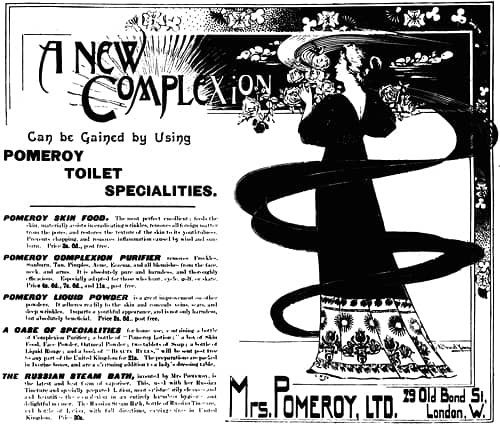
1897 Pomeroy Toilet Specialities.
Electrolysis
Jeannette said that she had undergone a course of instruction at a hospital (Cutler, 1907, p. 186) and it is possible that this was in electrolysis which formed a major part of her business.
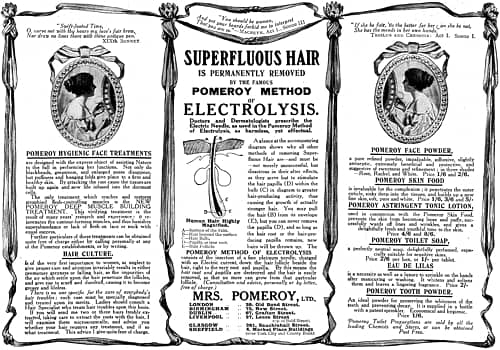
1909 Pomeroy Method of Electrolysis.
See also: Electrolysis
Skin-care
Jeannette had no formal training in Beauty Culture so her ideas on skin-care reflected common beliefs of the period. These she outlined in a little booklet ‘Beauty Rules’ which included missives advocating cleanliness, healthy nourishing food, exercise and positive thinking, all popular pieces of beauty advice for the time.
As might be expected of a late nineteenth-century, European ‘cosmetic specialist’, Pomeroy preparations promised to produce a clear, white, younger-looking skin, free of wrinkles and other skin blemishes.
With a wonderful skill Mrs. Pomeroy seems first to clear the skin from all impurities, and then, by her remarkable system of facial massage and the subsequent application of certain hygienic preparations, she removes wrinkles and crowsfeet, freckles, and blemishes of various kinds, leaving the complexion, at the end of her course of treatment, as fresh and smooth as the skin of a baby.
(Pomeroy advertorial, 1898)
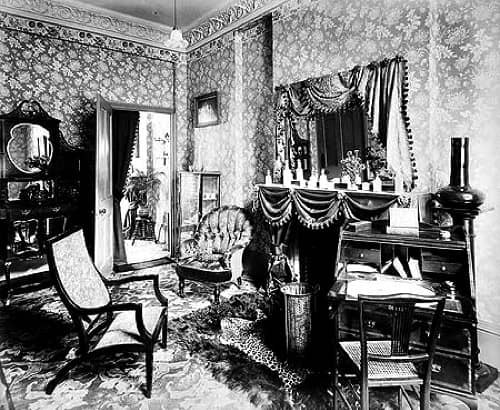
1896 The reception room at 29 Old Bond Street, London with Pomeroy products on the mantle-shelf.
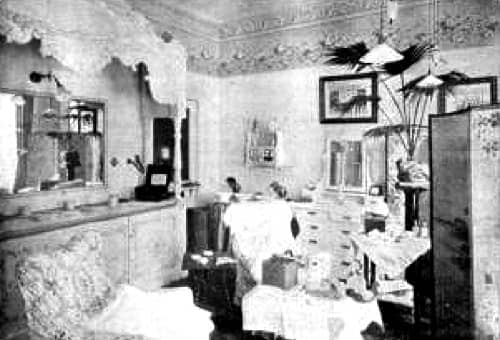
Above: 1903 One of the 10 treatment rooms at 29 Old Bond Street, London. Separate courses of Hygienic Complexion Treatments were provided for the face, neck, and neck and arms, Monday to Friday 10-5 and Saturdays 10-2. Note the square-shaped battery on the table used for electrolysis and other treatments.
Wrinkles
Jeannette regarded wrinkles as a sign of ‘exhausted tissues’, a common view of the time, a condition that could be rectified through the application of a ‘nourishing’ skin food massaged into the face.
Wrinkles, those merciless foes to beauty, are due to the lack of nourishment in the tissues, caused by ill-health and approaching age, or extremely poor care of the skin. To prevent their appearance, or to remove them if already present, is not a difficult matter, providing they are not of extreme old age.
(Pomeroy advertorial, 1898)
See also: Skin Foods
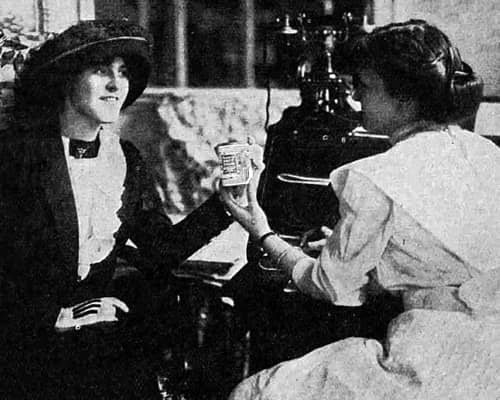
Above: 1912 Salon consultation with a client being offered a jar of Pomeroy Skin Food.
Skin foods were believed to be absorbed through the pores of the skin, so these needed to be cleansed thoroughly to free them of any inhibiting obstructions. Clearing blocked pores also enabled the skin to release ‘poisons’, a ‘well-known’ cause of ‘muddied’ complexions and skin blemishes. However, unlike her contemporary Frances Forsythe [1872-1934] (Cyclax), Jeannette did not advocate the use of soap on the face, preferring an oatmeal scrub instead.
Soap should not be used on the face, as the alkali contained in soap destroys the delicate outer skin. Soap is necessary to cleanse the pores of the body, which are full of fatty matter, but no matter bow greasy the face may be, it is much better cleansed and kept smooth by abundance of hot water and the use of Pomeroy Oatmeal Powder than by soap.
(Pomeroy advertorial, 1898)
See also: Cyclax
Jeannette was a ‘steamer’ and sold a small, portable, copper apparatus she called Mrs. Pomeroy’s Russian Steam Bath, recommending that it be used to cleanse the pores, for ten minutes, not more, at least once a week, more often if the pores were clogged or the skin suffered from pimples or blackheads. The proscription against using the steamer for more than ten minutes was probably to avoid the heat making the skin lax thereby accentuating wrinkles.
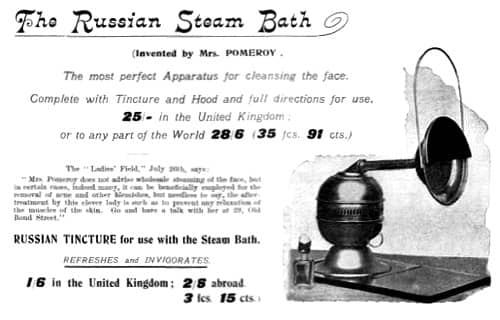
Above: 1903 The Russian Steamer. Rose-scented steam was sprayed onto the face under a funnel-like cloth draped over the bar.
Steaming was not endorsed by all beauty culturists of the time. Another contemporary of Jeannette’s, Eleanor Adair, was dead against it. Jeannette also differed from Adair in that, as far as I can tell, she did not use any form of strapping, preferring vigorous massage instead.
See also: Vaporisers (Steamers & Atomisers) and Eleanor Adair
Once the pores had been cleansed and the skin food applied, massaging commenced. The recommended massage movements were always upwards and across wrinkle lines, a practice that continues to this day. Kneading actions were concentrated on the cheeks to help plump them up. Like other Beauty Culturists of the period, Jeannette claimed that massage had a restorative effect on body tissues but, depending on how it was done, it could also be used to remove ‘superfluous flesh’.
This scientific treatment will help you where all others have failed. It is so different. Both in method and effect, it far surpasses all other systems practised. By restoring to the exhausted facial muscles their full, vigorous functions, it eradicates superabundant flesh, or fills up hollows with equal alacrity. It is no less effectual in removing the lines of advancing age or of illness.
The system also includes new treatments for the restoration of brightness to the eyes, beauty to the hair and shapeliness to the neck. In short, it is the surest method known of restoring and preserving the perfection of youthful loveliness.(Pomeroy advertisement, 1907)
See also: Massage, Wrinkles and Double Chins
Any excess skin food was then removed and an astringent was applied to ‘close the pores’ and tighten the skin.
The use of Pomeroy Astringent Tonic Lotion prevents wrinkles, keeps the skin smooth, soft, and healthy, soothes all smarting and the roughness which follows exposure to the wind, and gives to the skin and complexion the velvety touch of a rose leaf.
(Pomeroy advertorial, 1898)
See also: Skin Tonics, Astringents and Toners
Freckles
Having spent a good deal of her life in sunny India, freckles received particular attention in Jeannette’s beauty regime. She held the common view that freckles came in two forms; ‘summer freckles’ that were easy to remove, and ‘winter freckles’ that were due to a more deep-set excess of bile in the blood. She was evasive about how she would treat winter freckles – although a change of diet to help the liver was probably part of the solution – but recommended that the summer type could be removed with a few applications of Pomeroy Complexion Purifier. If, as I suspect, it contained a mercury compound such as bichloride of mercury (corrosive sublimate), it would have produced the desired result.
See also: Mercolized Wax
Early preparations
The Mrs. Pomeroy preparations on sale covered all the normal requirements for a woman of the time. As well as the usual skin-care products, Jeannette sold a face powder and rouge which enabled a woman to cover any blemishes or sallowness that was not immediately treatable. Liquid powder was also used as a safeguard against the ‘drying influence of the sun and air’.
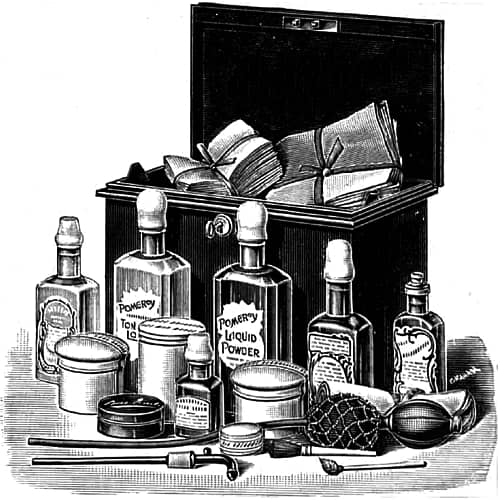
Above: 1904 Pomeroy Travel Box.
Considering that these preparations had to survive long sea voyages and hot climates they were probably petroleum-based. This enabled the Pomeroy Skin Food, most likely a type of cold cream, to be advertised as “containing no glycerine, lanoline or animal fat” (Pomeroy advertorial, 1905).
Skin Food: “The most perfect emollient; feeds the skin, materially assists in eradicating wrinkles, removes all foreign matter from the pores, and restores the texture of the skin to its youthfulness. Prevents chapping and removes inflammation caused by wind and sunburn.”
Complexion Purifier: “[R]emoves Freckles, Sunburn, Tan, Pimples, Acne, Eczema, and all blemishes from the face, neck, and arms. It is absolutely pure and harmless, and thoroughly efficacious. Especially adapted for those who hunt, cycle, golf, or skate.”
Astringent Tonic Lotion: “[S]uitable for those who have naturally good complexions, and only need to keep away wrinkles and prevent the skin from becoming flabby.”
Oatmeal Powder: “An excellent substitute for soap, and especially suited to greasy skins.”
for those who hunt, cycle, golf, or skate.”
Pearl Enamel: “It is the best of its kind, and is recommended to conceal veins, scars, and deep wrinkles of long standing; imparts a youthful appearance to the skin.”
Soap: “[T]he best and purest Soap made. Non-Alkaline; perfect for the hands and in the bath; suits the most delicate skin.”
Liline “An exquisite preparation for whitening and softening the hands and face. Prevents chapping and roughness.”
Face Powder: “Absolutely pure, hygienic, sanative, impalpable; contains no lead, chalk, or bismuth; unsurpassed as a Toilet and Nursery Powder. Rose for fair complexions, and Rachel for brunettes.”
Liquid Powder: “[A] great improvement on other powders. It adheres readily to the skin, and conceals veins, scars, and deep wrinkles. Imparts a youthful appearance, and is not only harmless, but absolutely beneficial.”
Liquid Rouge: “[F]or lips, face, and finger nails. A perfect semblance of the natural colour, the loss of which is due to ill-health or anaemia.”
Eyelash Cream: “Arrests inflammation of eyelids, strengthens and greatly promotes growth of lashes; also thickens eyebrows.”
Hair Tonic: “Cleanses and invigorates the scalp, and promotes a luxuriant growth of the hair.”
Home treatments
Many Pomeroy clients were in parts of the British Empire that were without the benefit of a Pomeroy salon. Jeannette provided these clients with home treatment regimes using products they could purchase via mail-order. Women could buy items individually or purchase a complete outfit with or without a Russian Steam Bath.
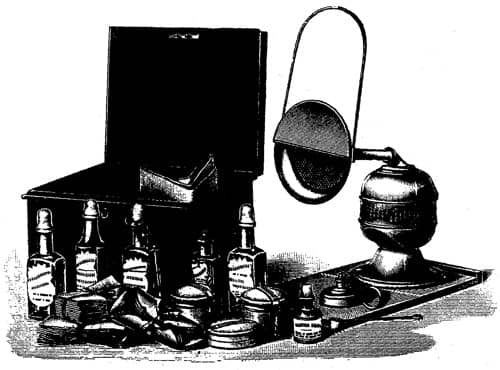
Above: 1903 Pomeroy complete outfit. A black japanned box containing the Russian Steam Bath, Russian Tincture, Skin Food for massage, Oatmeal Powder for removing greasiness, Astringent Lotion for toning the pores, Muslins for removing superfluous Skin Food, Soft Leathers for polishing the skin, Liquid Powder (with brush) for protecting the complexion, Face Powder, Liline, Dentifrice, Complexion Purifier for freckles, instructions, etc.
Given her time in India she must have been very familiar with the practice of purchasing ‘essentials’ from abroad. She published these routines as advertorials in various colonial newspapers and, by 1898, Pomeroy preparations were being advertised as far away as Australia and New Zealand.
(I). The face should be steamed for ten minutes not more, after which it should be gently but firmly massaged with Pomeroy Skin Food, using, the tips of the fingers, and rubbing across the lines, to remove wrinkles, always with upward movements, as shown in the diagram.
(2). To the cheeks firm and plump, place the palms of the hands firmly on the cheeks and roll them, the movement always being upward, using the Skin Food, which feeds the skin and facilitates the deep rolling of the muscles. The face should be thoroughly massaged for five minutes, alternating the movements, as above described, after which take a piece of soft linen and wipe off the Skin Food that has not been absorbed by the pores.
(3). Now apply a paste, the consistency of thick cream, made of a teaspoonful of Pomeroy Oatmeal Powder mixed with water, and rub it thoroughly into the face, following the lines of the diagram with the same movements as before. The oatmeal paste should roll off in dry crumbs under neath the hands, making the face as clean and smooth as a baby’s.
(4). The pores are now thoroughly cleansed, and should be closed and toned up by the application of Pomeroy Astringent lotion and a slight dust of Pomeroy Face Powder, or Liquid Powder, maybe applied if preferred. This treatment should be carried out once a once a week, or twice if the pores are very clogged, or the complexion marred by acne or blackheads. …
(5). The daily treatment of the skin after it has been thoroughly cleansed and invigorated by the above method should be to wash it at night, laving it well with warm water, to which has been added a small quantity of Pomeroy Oatmeal Powder, for at least five minutes, massaging the face with the tips of the fingers, which should be constantly wetted in the water. The morning ablution should be with cold water, which acts as a tonic to the skin, in conjunction with the Astringent Tonic Lotion, which should be dabbed on the face and allowed to dry, after which may be applied Face Powder or Liquid Powder, if desired.(The Australasian, 1898, p. 36)
The Pomeroy Skin Food functioned as a cleanser and massage medium, while the Pomeroy Oatmeal Powder – which was applied after the Pomeroy Skin Food – worked as an exfoliating mask.
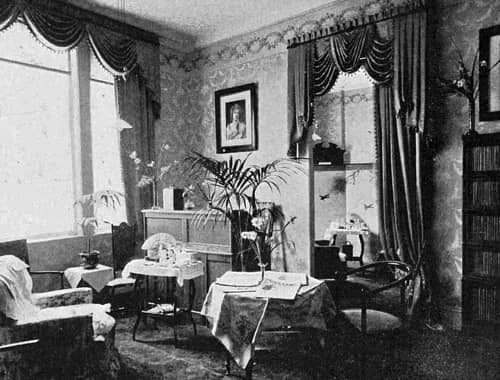
Above: 1904 Showroom at Mrs. Pomeroy, Central House, 75 New Street, Birmingham.
Electrical treatments
Like many other beauty culturists of the time, Jeannette used electricity in a number of her beauty treatments and sold electrical machinery that could be used by clients at home.

Above: 1903 Combined galvanic and faradic battery with attachments. Clients could purchase this apparatus through the post. It was used “for stimulating the skin and muscles, and preventing and removing wrinkles”.
Looking at the attachments on display, and given that the battery Jeannette used generated galvanic and faradic currents, it would appear that she used galvanic electricity for electrolysis and as a general ‘life stimulant’, to assist with problems like hair loss, and faradic currents to initiate muscle contractions, to tone up loose and flaccid skin and reduce wrinkles.
See also: Galvanic Treatments
Liquidation and sale
By 1905, Jeannette had personally opened Mrs. Pomeroy salons in Glasgow, Dublin, Birmingham, Liverpool, Cape Town and Johannesburg and was also selling products in other parts of the British Empire.

Above: Pomeroy Salon at 39 Grafton Street, Dublin.
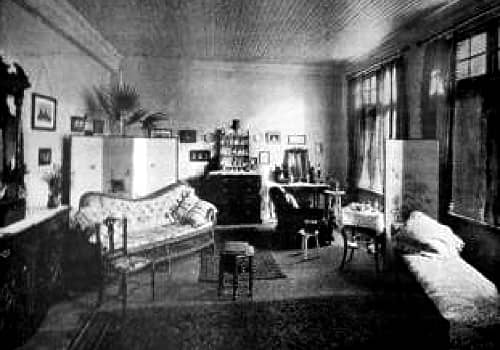
Above: Pomeroy Salon at 80 Strand Street, Cape Town.
All Mrs. Pomeroy’s toilet articles are made on her own premises, so that she can guarantee their composition and purity, and they are now sold by all chemists throughout the world, and by her special agents in India—Kemp and Co., Bombay; Smith, Stanistreet, and Co., Calcutta; Fitch and Co., Mussoorie; J. Bliss, Karachi. Australia—Faulding and Co., Sydney, Perth, and Adelaide; Elliott Bros., and J. Weiner and Co., Sydney; Felton, Grimwade, and Co., Melbourne. Paris—Monville-Lavaill, 11, Rue Daunou. Italy—F. Mantovani, Milan and Naples; and from her own establishment at 10, Duncan’s Building Capetown, or from all branches of Messrs, Lennon, Ltd., chemists throughout South Africa.
(Pomeroy advertisement, 1905)
The business had a turnover of up to £21,000 per year and employed as many as eighty people (Cutler, 1907, p. 186). However, this did not stop the company from becoming ‘embarrassed’ towards the end of 1905. Given the amount of advertising she did, her travelling expenses, staffing costs, and the quality of the salon fittings and fixtures, one can see how a cash flow problem might occur. The result was that the company went into voluntary liquidation and was sold to E. H. Girling in 1906.
Jeannette was asked if she would like to continue to manage the business with a base salary of £1200 a year, along with a share of the profits. She declined and elected instead to open a new salon as Jeannette Pomeroy down the road, first at 33, then at 35 Old Bond Street, offering treatments using Mrs. Pomeroy products she acquired from chemists. She also had the family’s surname changed by deed poll to Pomeroy after separating from James Scalé earlier in the year.
She had a list of the customers made from the index cards, and took it away. She then executed a Deed to change her name to Pomeroy and also a Deed of separation from Mr Scaleé. … She put up a brass plate with the name “Jeannette Pomeroy” in an imitation of her handwriting. At 33 Old Bond Street, she sold the Company’s preparations, which she bought from chemists who had obtained them from the Company.
(Cutler, 1907, p. 184)
As might have been expected, she was taken to court over her use of the name Pomeroy. She lost the trade-mark case and was force to close her new business in short order. This ended Jeannette’s connection with Beauty Culture and she left for America with her two sons in 1908. In 1915, she moved with her younger son Amos (Roy) Pomeroy [1892-1947] to Indianapolis and with him again he moved to New York to work as a portrait painter and scenic artist. In 1922, Roy moved to California with his future wife, Sylvia Jewel [1894-1977], a.k.a. Sylvia Whittaker, where he played a significant part in the development the Hollywood motion picture industry. Jeannette did not go with them. In 1921, she was admitted to the Wards Island Mental Hospital, New York, and was then deported from the United States back to Britain in 1922. She spent most of the remaining years of her years in British mental institutions, dying in 1938.
New owner
The new owner, E. H. Girling, admitted to knowing nothing about Beauty Culture and I imagine he relied heavily on the existing staff to familiarise himself with the company operations.
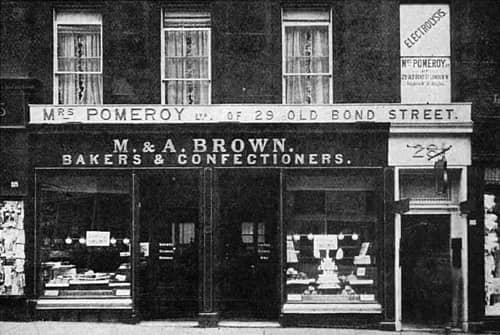
Above: 1909 Entrance to Mrs. Pomeroy at 281 Sauchiehall Street, Glasgow.
Unfortunately, I know little of the firm’s activities in the 1910s and 1920s. The salons in Johannesburg and Cape Town were closed down but the company continued to sell its products throughout the British Empire and elsewhere. At home, salons were established in Manchester and Sheffield by 1910 and a new London salon was opened at 185 High Street, Kensington at the end of the First World War.
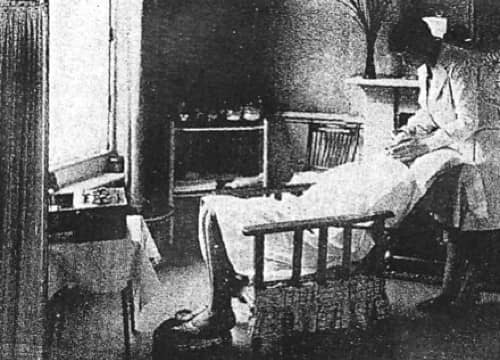
Above: 1928 Pomeroy facial treatment.
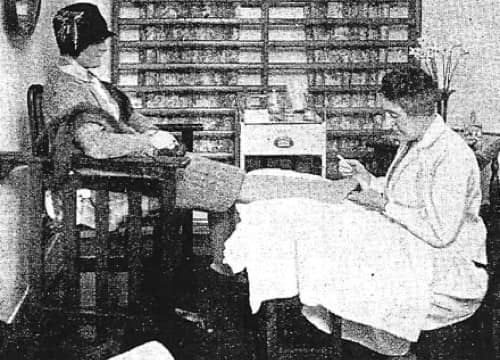
Above: 1928 Pomeroy chiropody treatment.
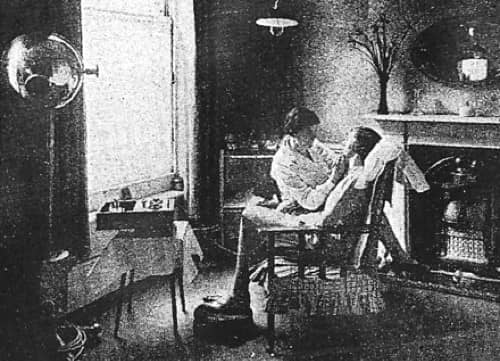
Above: 1928 Pomeroy electrolysis treatment.
In 1911, the new owner also introduced a badly needed Pomeroy Day Cream into the product range. It was a type of vanishing cream, featured prominently in Pomeroy advertising from then on. It gave the company a much needed base for powder and other make-up that was becoming more widely used during the 1920s.
Pomeroy Day Cream: “[N]on-greasy ‘vanishing’ cream which ladies use just before going out. It prevents ‘shininess,’ keeps the skin soft and smooth, and preserves the bloom of the complexion.”
Other new products were added, giving the company an extended skin-care and make-up range by the middle of the 1930s. These were repackaged in modern looking bottles using a logo designed by Edward McKnight Kauffer [1890-1954] that the company had first used in 1922.
Skin-care
By the 1930s, the Pomeroy skin-care treatment had undergone a considerable alterations due to the inclusion of new lines. Pomeroy Beauty Milk was now used as the primary cleanser, displacing the Pomeroy Skin Food and Pomeroy Toilet Oatmeal, the later only recommended for oily skin.
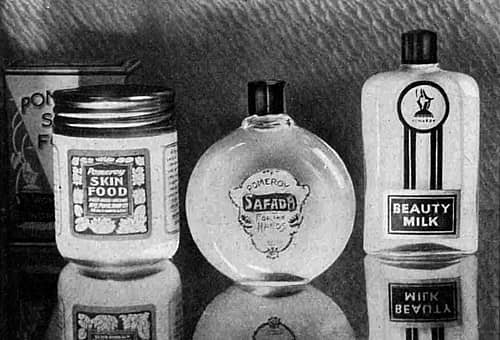
Above: 1932 Pomeroy Skin Food, Safada and Beauty Milk.
Pomeroy Skin Food was now a night cream, although the company hedged its bets by suggesting that it could be applied before a bath or any time during the day, if desired. Pomeroy Day Cream, like other vanishing creams, was used under make-up during the day and as a skin protectant, maintaining the position it had established before the First World War.

Above: 1932 Pomeroy Liline (jar and tube), Face powder and Skin Food (tube and jar).
As well as more clearly demarcating day and night treatments, the Pomeroy product line made additional allowances for dry and sensitive skin types. There was Pomeroy Eau des Fleurs skin tonic for sensitive skin, to complement the older and stronger Astringent Lotion; Pomeroy Dathos Cream, used in place of Pomeroy Skin Food if the skin was dry; and Pomeroy Cleansing Cream (possibly a liquefying cleansing cream) for cleansing oily skin.
The preliminary step in beauty culture is the establishment of perfect skin hygiene.
This is accomplished by cleansing the face and neck thoroughly with Pomeroy Beauty Milk, a soothing penetrating emulsion.
After cleansing, the skin is covered liberally with Pomeroy Skin Food, which is carefully massaged into the tissues …
If the skin is exceptionally dry, Pomeroy Dathos, a super-fatted skin nutrient is used in place of the Skin Food. At night, before retiring, is the best time for this part of the treatment. In the morning, after bathing the face freely with cold or tepid water, the skin is again cleansed with Pomeroy Beauty Milk or, if included to be greasy, with a little Pomeroy Toilet Oatmeal made into a paste with water. The face and neck are then sprayed with Pomeroy astringent lotion.
If the skin is very sensitive, Pomeroy Eau des Fleurs, a milder skin tonic, is recommended in preference to the Astringent. Both these lotions should be allowed to dry on the skin naturally.
Now a covering of Pomeroy Day Cream is gently applied with the tips of the fingers. This affords perfect day-time protection.(Pomeroy, c.1936)
See also: Liquefying Cleansing Creams
One unusual aspect of the Pomeroy skin regime was that it was partly based on a woman’s colouring. For example, it was suggested that a woman with naturally black hair should use Pomeroy Cleansing Cream as a night cream, presumably because her skin was oily, whereas a woman with white hair, which suggests she was older, was recommended to use Pomeroy Skin Food. The Day Cream, which only came in two colours, was also selected by skin colour, with Pink for dark skins and White for skins that were fair.
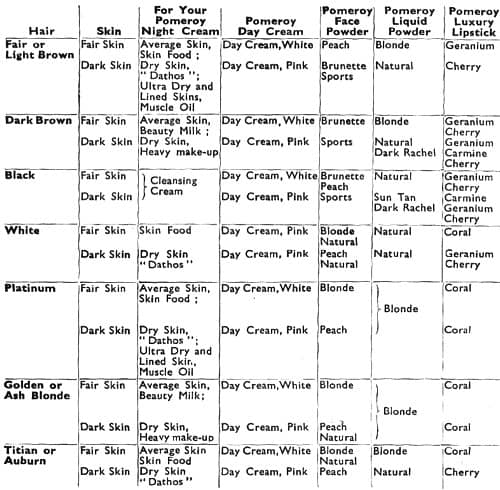
Above: c.1936 Part of a Pomeroy colour chart showing the relationships between hair, skin, night cream, day cream, powder and lipstick. It is clear from this chart and other material that Pomeroy only catered for ‘English complexions’.
Also see: Pomeroy Beauty for All (c.1936)
Massage was still considered an essential part of any Pomeroy beauty treatment and, like many other companies, instructions were given on how to do this at home. After cleansing the face with either Beauty Milk or Cleansing Cream, facial massage movements were conducted using Pomeroy Skin Food or Pomeroy Dathos Cream, with Muscle Oil being applied in areas that were particularly wrinkled, a common treatment for the time.
See also: Muscle Oils
Specialist skin treatments were few but included the Pomeroy Complexion Purifier, which was still being applied to reduce freckles and discolourations of the skin; a Blackhead Treatment, consisting of a cream and lotion; an Eyelash Lotion, a ‘soothing, cleansing, safe lotion for tired or aching eyes’; and Pomeroy Muscle Oil which was used on ‘thin necks and very wrinkled necks and eyes’. However, should a woman throw caution to the wind, dispense with her Pomeroy Liquid Powder (Liline), and expose her skin to the elements, sun products were available including: Sunburn Cream, to prevent blistering or skin peeling; and Sun Tan Oil, to provide an even tan.
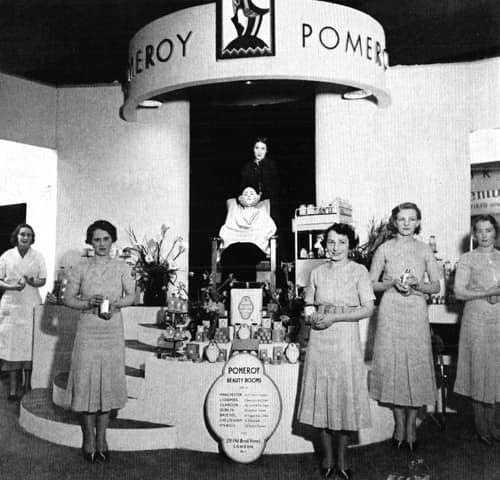
Above: 1936 Pomeroy stand at the Ideal Homes Exhibition in London.
Make-up
By the late 1930s, Pomeroy had a small but serviceable make-up range which included face powder, lipstick, rouge, mascara, eyebrow pencil and eyeshadow.
Pomeroy Face Powder was made in loose and compressed forms in Blonde, Brunette, Green, Mauresque, Mauve, Natural, Peach, Rachel, Dark Rachel, Sports, Sun Tan, and White shades. Liline liquid powder only came in shades of Blonde, Natural, Rachel, Dark Rachel, Sun Tan, and White.
Pomeroy Luxury Lipstick came in Carmine, Cherry, Colourless, Coral, Geranium, Natural, and Tangerine shades which could be matched with either Rouge Powder in Blonde, and Brunette shades; Compressed Rouge, in Blonde, Brunette, and Tangerine shades; Cremor Rouge, a complexion tinting cream in Carmine, Cherry, Coral, Geranium, and Tangerine shades; or Liquid Rouge in Carmine, Coral, and Peach shades. Pomeroy recommended that Cremor Rouge be applied to the upper part of the cheeks, the lobes of the ears and the point of the chin, taking care that it not be too obvious.
Eye make-up included Mascara in Black, Brown, and Chatain (light-brown) shades; Eye Shadow, in cream and compressed powder forms, came in Blue (for blue-grey eyes), Green, and Brown (for green, brown and hazel eyes); and an eyebrow pencil in Black, Blue, Brown, Chatain, and Green. Pomeroy also made an Eyelash Cream to keep the eyelashes ‘supple and well nourished’.
Along with other items in the Pomeroy range – which included soap, bath products, cleansing tissues and toothpaste – the Pomeroy hand and nail products are worth noting. These consisted of Safâda Hand Lotion; Cleansing Fluid, for removing stains from hands and nails; a Cuticle Cream; Nail Polishing Cream; Nail Varnish in Carmine, Cherry, Colourless, Coral, Geranium, and Tangerine shades; and Nail Varnish Remover.
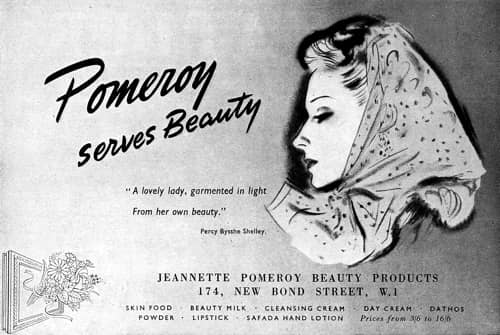
Above: 1944 Jeanette Pomeroy Beauty Products now manufactured by F. W. Hampshire & Co., Ltd.
Postwar period
In 1940, Pomeroy was bought by F. W. Hampshire & Co., Ltd. of Derby, England, manufacturing chemists noted for such products as Zube lozenges and Snowfire cosmetics. They began referring to Pomeroy as Jeannette Pomeroy in their advertising but backtracked on this after the war. They also moved the London salon to 174 New Bond Street in 1943, recapitalised the business in 1946 by founding Mrs. Pomeroy, Ltd. (capital £20,000), repackaged the line in 1946, and remodelled the salon in 1948.
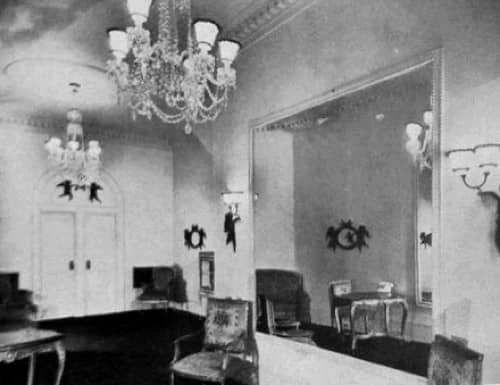
Above: 1948 Reception room at the 174 Bond Street salon in marble cream terrazzo with cupids and the Pomeroy ‘Dove in Flight’ emblem over the door. Furniture in the salon is in the Louis XVI style.
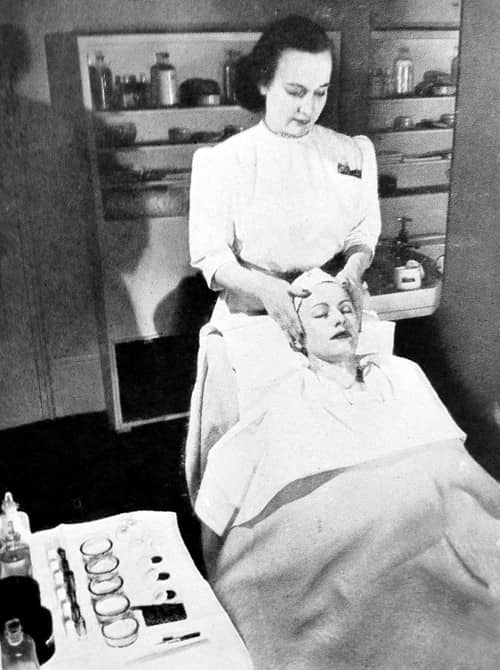
Above: 1948 Treatment room at the 174 Bond Street salon.
See also: F. W. Hampshire
Skin-care
There appears to have been little change in the Pomeroy skin-care lines or treatments in the years following the war but new make-up products were introduced. The make-up colour ranges were still restricted but the company made some attempt to move with the times and respond to the changes in fashion brought about by the introduction of Dior’s New Look in 1947.

Above: 1948 Pomeroy products moulded in Beetle by Universal Metal Products, Ltd. From left to right these are Back: Pomeroy Beauty Milk (package and bottle), Pomeroy Skin Food, Pomeroy Liquid Foundation (package and bottle), Pomeroy Eau Des Fleurs (bottle and package); Front: Pomeroy Skin Food, Lipstick, Rouge and Pomeroy Day Cream.
Make-up
As well as Pomeroy Face Powder, which still came in only five shades – Peach Bloom, English Rose, Medium Rachel, Rose Rachel, and Sports – there were now five powder foundations available. Pomeroy Liquid Foundation for oily and normal skins, made in the same shades as Pomeroy Face Powder; Pomeroy Day Cream, a white vanishing cream; Pomeroy Make-up Base, a heavy flesh-tone cream for dry skins; Pomeroy Make-up Cake in the same shades as Pomeroy Face Powder; and Pomeroy Foundation Cream, a peach-tinted cream, suitable for dry skins but giving a softer and lighter make-up than the Pomeroy Make-up Base.
Colouring for lips and cheeks was made in cream rouge and matching lipsticks in eight shades — Almond Blossom, Pomeroy Pink, Coral, Russet, Fantasy, Red Cap, Tudor Rose, and Cherry — the first products that deviate from using standard colour names like carmine, tangerine, and geranium. For those who preferred it, Pomeroy Liquid Rouge was still available but only in Carmine, and Geranium shades. Compared with make-up ranges from American brands of the time – like Revlon, Elizabeth Arden, and Max Factor – the Pomeroy shade range could only be described as ‘serviceable’.
End of the line
Despite the attempted rejuvenation of the line in the late 1940s, the brand did not survive for much longer and it disappeared somewhere in the 1950s. The brand name was later acquired by Richards & Appleby, Ltd. – who also owned Cyclax for a time – but, after careful consideration, they decided not to revive it.
Timeline
| 1895 | Mrs. Pomeroy complexion specialist opens in Chancery Lane, London. |
| 1896 | Moves to 29 Old Bond Street, London. Mrs. Pomeroy Ltd. established. |
| 1902 | Salons opened in Liverpool, Dublin and Capetown. |
| 1904 | Offices and factory of Mrs. Pomeroy moved from 29 Old Bond Street to 33-34 Carnaby Street, Great Marlborough Street, London. Salons opened in Birmingham and Johannesburg. |
| 1906 | Mrs. Pomeroy, Ltd. goes into voluntary liquidation. Assets sold to E. H. Girling who establishes a new Mrs. Pomeroy, Ltd. |
| 1913 | Mrs. Pomeroy, Ltd. moves from Carnaby Street to 115 Waltham Road, Harwood Green. |
| 1919 | A second London salon established at 185 High Street, Kensington. |
| 1932 | Pomeroy line repackaged. |
| 1936 | Mrs. Pomeroy (Ireland), Ltd. registered in Dublin. Central News Agency, Ltd. appointed Pomeroy agents in the Union of South Africa. Pomeroy line repackaged. |
| 1939 | New Products: Skin Conditioner. |
| 1940 | Mrs. Pomeroy bought by F. W. Hampshire & Co., Ltd. Mrs. Pomeroy, Ltd. established. |
| 1941 | Mrs. Pomeroy moves to 27 Old Bond Street. |
| 1943 | Salon moved to 174 Bond Street. |
| 1946 | Mrs. Pomeroy recapitalises. Pomeroy line repackaged. |
| 1948 | Salon at 174 New Bond Street remodelled. |
First Posted: 19th May 2014
Last Update: 20th November 2024
Sources
Browning, E. H. (1898). Beauty Culture. London: Hutchinson & Co.
Clarke, J. P. (2013). Pomeroy v. Pomeroy: Beauty, modernity, and the female entrepreneur in fin-de-siècle London. Women’s History Review, 22(6), 877-903.
Cutler, J. (Ed.). (1907). Reports of the patent, design, trade mark and other cases, Vol. XXIV. London: His Majesty’s Stationary Office.
Howarth, M. (1901). What women will do for looks. The Harmsworth London Magazine. 7, 259-264.
Pomeroy (c.1936). Pomeroy beauty for all. [Booklet]. London: Author.
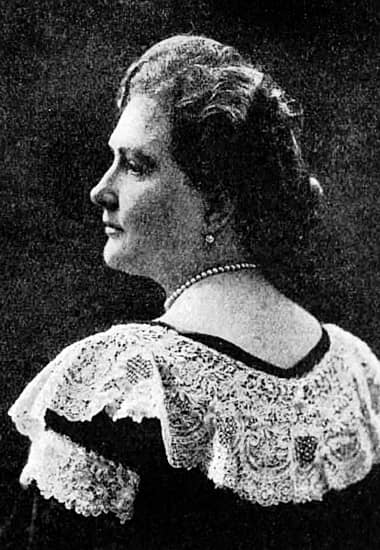
1903 Jeannette Scalé née Hauser [1862-1938]. Described as being 5' 4" tall (163 cm), of fair complexion, with blonde hair and blue eyes, she began Mrs. Pomeroy in 1895 using the name Jeannette Pomeroy.
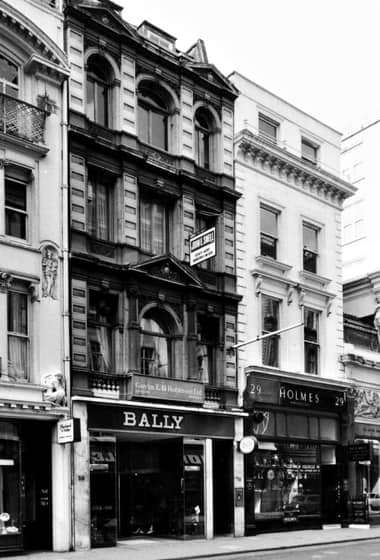
The building at 29 Old Bond Street (right), next to the Royal Arcade, as it appeared in 1975. Mrs Pomeroy carried on her business upstairs.
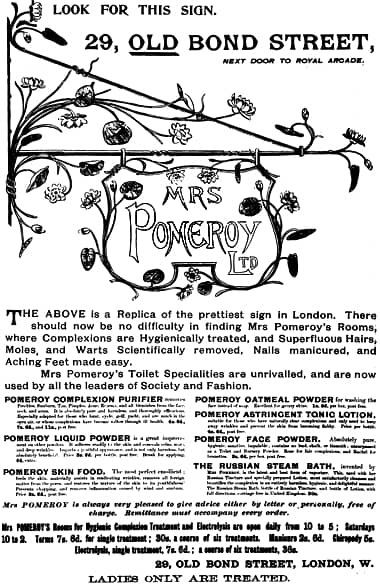
1897 Mrs. Pomeroy at 29 Old Bond Street.
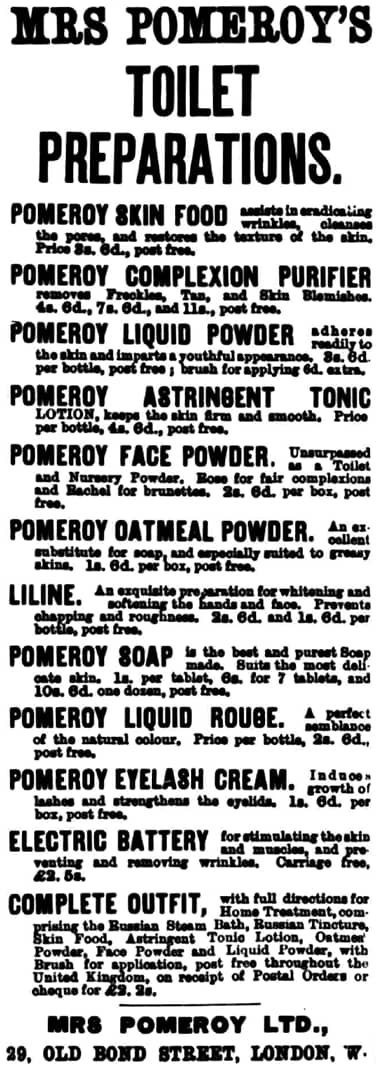
1899 Mrs. Pomeroy toilet Preparations.
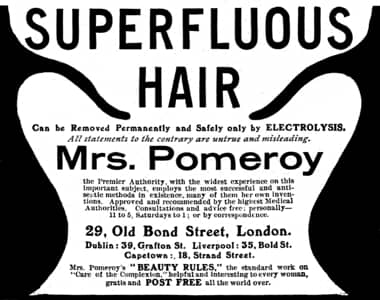
1903 Mrs. Pomeroy Electrolysis.

1904 Mrs. Pomeroy.
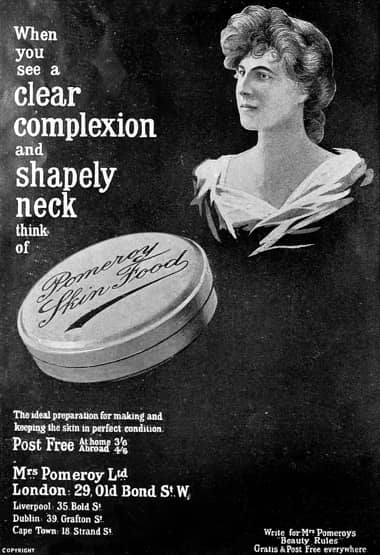
1904 Pomeroy Skin Food.
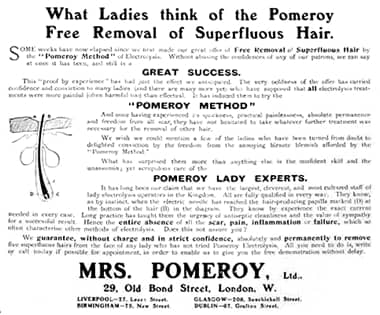
1908 Pomeroy electrolysis treatments for removing superfluous hair.
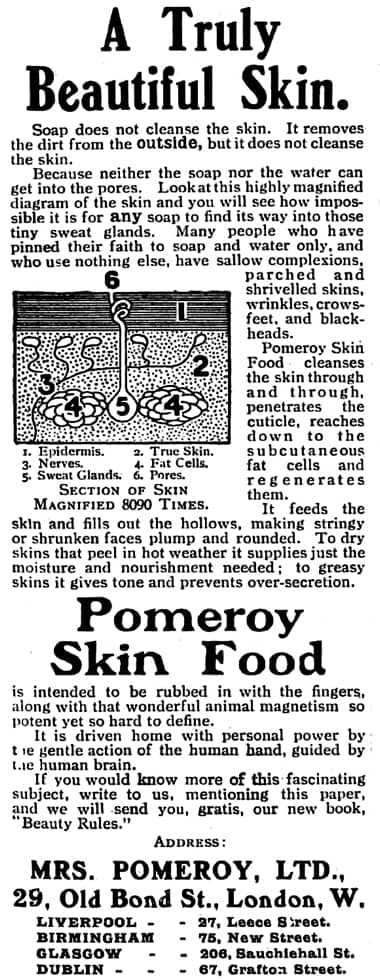
1908 Pomeroy Skin Food.
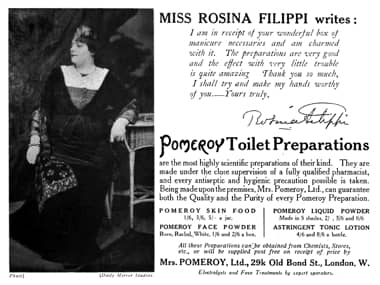
1911 Rosina Filippi [1866-1930] endorsement for Pomeroy Toilet Preparations.
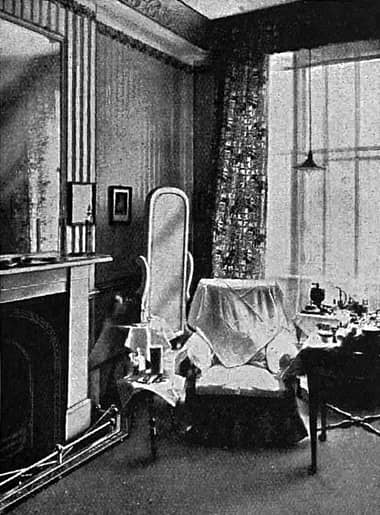
1912 Treatment room at Mrs Pomeroy, 29 Old Bond Street, London.
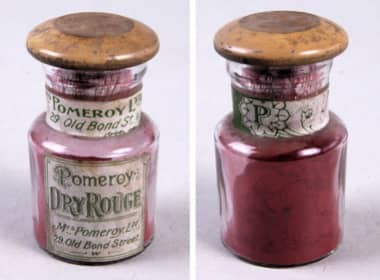
Pomeroy Dry Rouge. Date unknown.
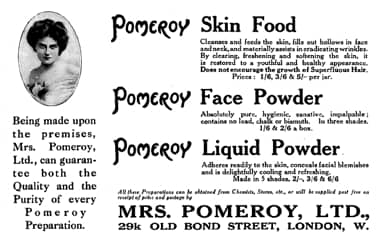
1913 Pomeroy Skin Food, Face Powder and Liquid Powder. The face powder (advertised as containing no lead, chalk or bismuth) came in three shades (Rose, Rachel and White) whereas the liquid powder came in five (Fresh Pink, Pale Pink, White, Rachel and Pale Rachel).
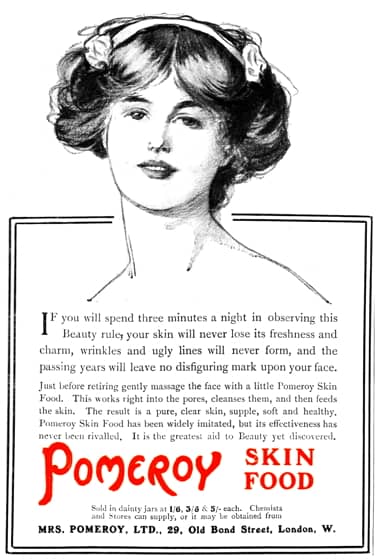
1914 Pomeroy Skin Food.
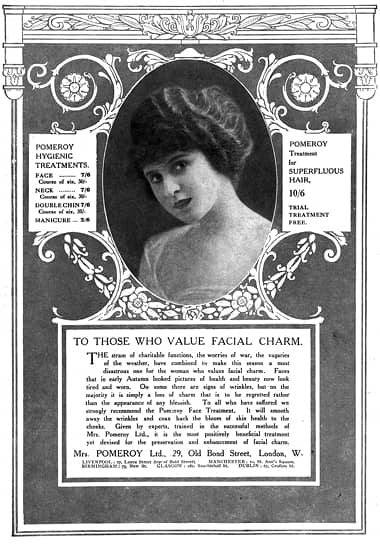
1915 Pomeroy Hygienic Treatments.

1917 Pomeroy Day Cream. This advertisement was aimed at munitions workers.
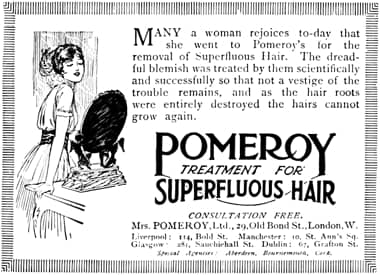
1917 Pomeroy Treatment for Superfluous Hair.
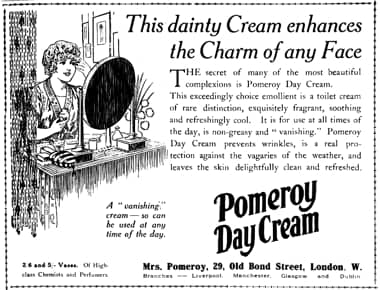
1918 Pomeroy Day Cream.
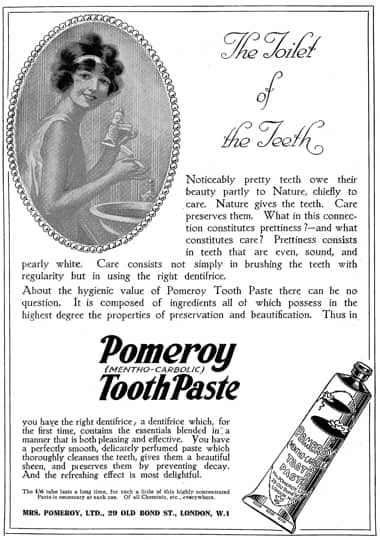
1919 Pomeroy Tooth Paste.

1920 Pomeroy Treatment Rooms.
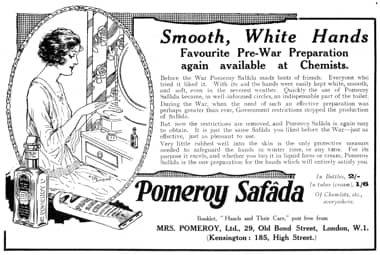
1920 Pomeroy Safâda hand cream in bottle and tube. The bottle form would be discontinued later.
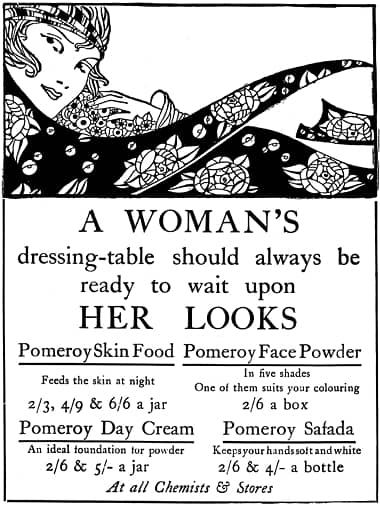
1922 Pomeroy Skin Food, Day Cream, Face Powder and Safada.

1922 Pomeroy Day Cream with new Pomeroy Logo designed by Edward McKnight Kauffer. The logo was usually printed with the Latin motto “Probatum est” meaning proven or trustworthy.
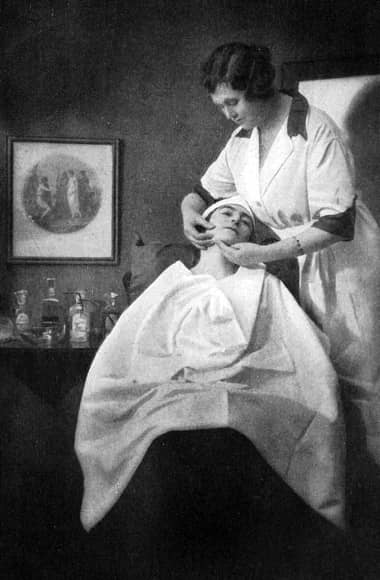
1923 Face massage in a Pomeroy salon.
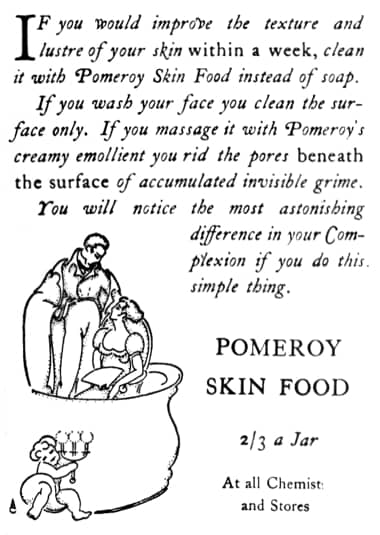
1923 Pomeroy Skin Food.

1924 Pomeroy Day Cream.
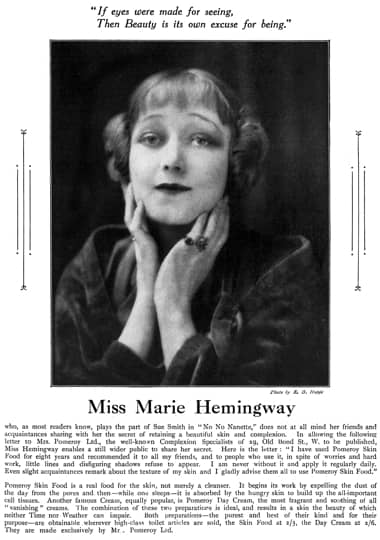
1925 Marie Hemingway [1889-1938] endorsing Mrs Pomeroy.
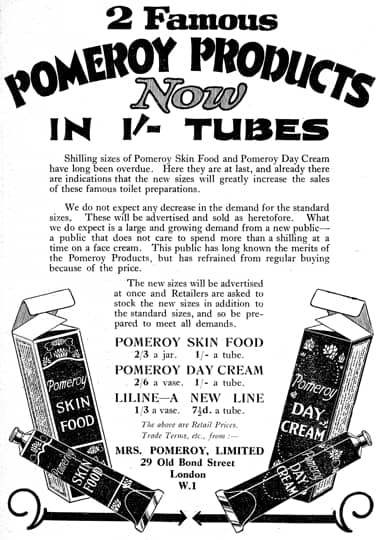
1927 Pomeroy Skin Food and Day Cream now in tubes.
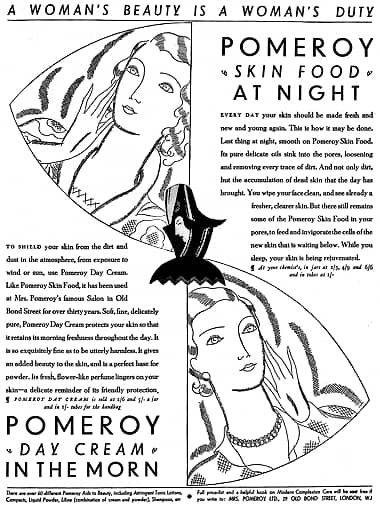
1931 Pomeroy Skin Food and Day Cream.
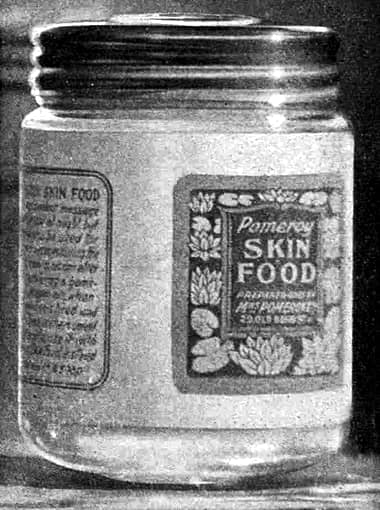
1931 Pomeroy Skin Food.

1932 Pomeroy Liline Powder Cream in Natural, Ivory and White shades. The shade range was increased during the 1930 adding darker tints for women who sunbathed. The Liline name appears to have been dropped after the company was sold in 1940.
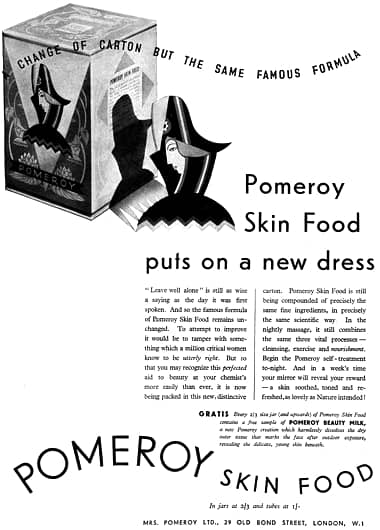
1932 Pomeroy Skin Food in new packaging.
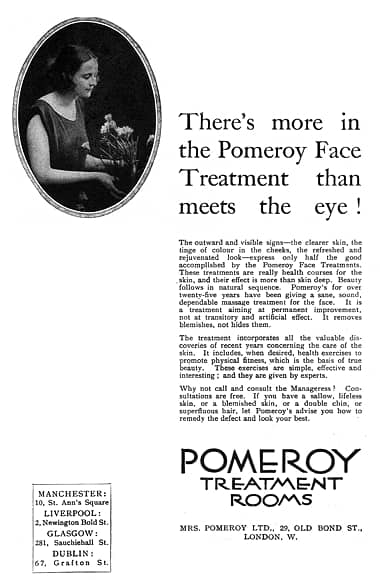
1935 Pomeroy Treatment Rooms.
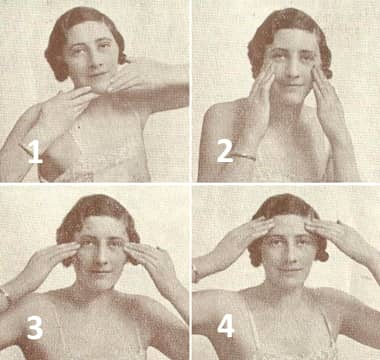
Pomeroy Massage movements
Massage movement No. 1.
For correcting and preserving the oval contour of the face, tightening the neck muscles and removing superfluous tissues from under the chin.
Using the hands alternatively, massage the neck eight or ten times with a downward and outward rotary movement; then with the fingers (as Fig. 1) stoke firmly under the chin upwards to the lobe of the ear the same number of times.
Massage movement No. 2.
For lifting and stimulating the cheek muscles and for reducing smile furrows extending from the nose to the corners of the mouth.
Stimulate the tissues by patting the cheeks lightly with the fingers and then massage with both hands (as Fig. 2) eight or ten times with an upward and outward rotary movement, from under the nose across the smile lines and over the cheeks as far as the ears.
Massage movement No. 3.
For toning up tissues round the eyes and to remove wrinkles, crow’s feet, puffiness, and sagging.
Take a little more Skin Food on the fingers and tap it in under the eyes and over wrinkles. Commencing (as Fig. 3) at the outer corner of the eye, massage very gently with a rotary movement inwards towards the nose, then stroke gently over the eyelids.
Massage movement No. 4.
For lifting eyebrow muscles and to correct and remove forehead lines and frown furrows.
With the thumb and second finger of both hands stroke gently above and below the eyebrows several times outwards with a slight lifting movement. Starting from the centre of the forehead, using the tips of the fingers (as Fig. 4), massage with deep rotary movements upwards and outwards, and follow this with stroking movements outwards.
(Pomeroy, c.1936)

1939 Pomeroy Beauty Preparations.

1939 Pomeroy products for sun worshippers.
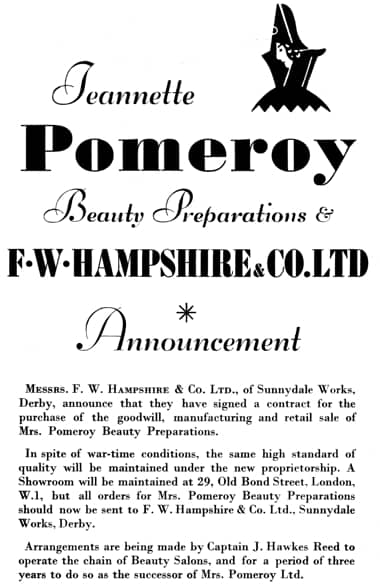
1940 Trade announcement that manufacturing and retail of Pomeroy products had been taken over by F. W. Hampshire & Co. Ltd.
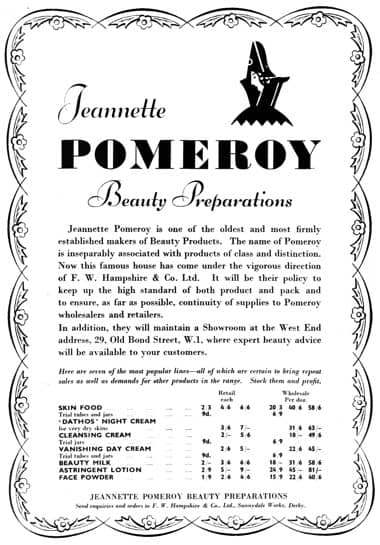
1940 Pomeroy trade advertisement listing seven popular Pomeroy lines.
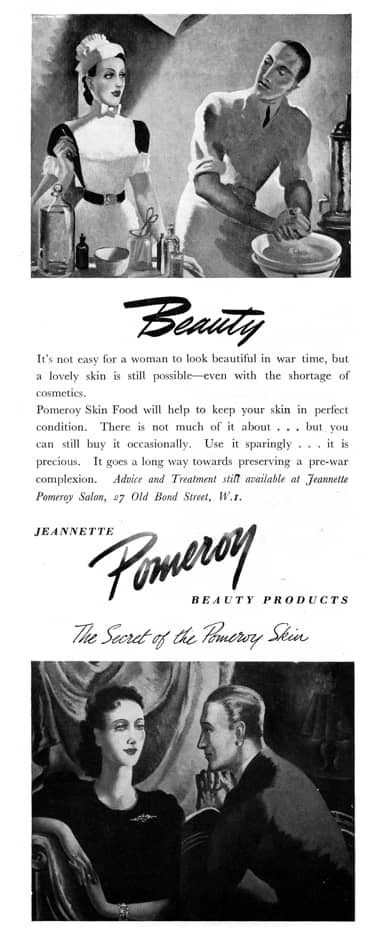
1941 Jeannette Pomeroy Beauty Products. Note the use of Jeannette Pomeroy rather than Mrs. Pomeroy.
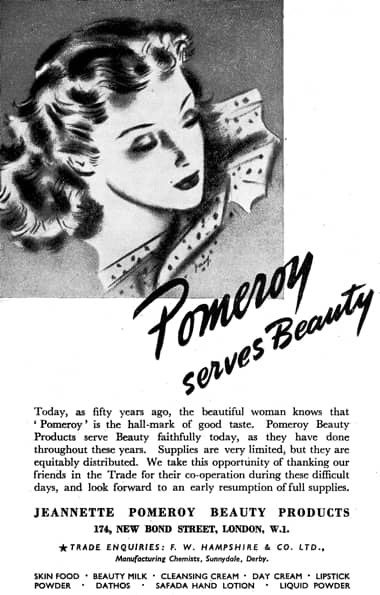
1945 Pomeroy trade advertisement.
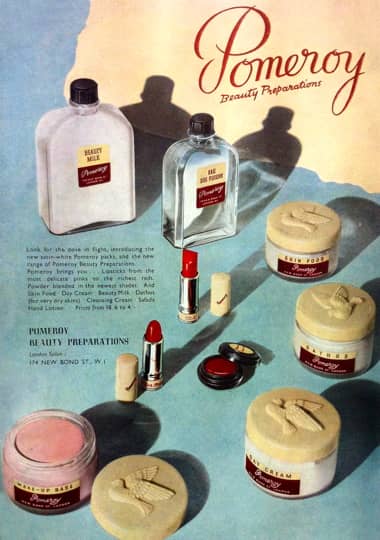
1946 Pomeroy Beauty Preparations. The line was repackaged in 1946 with burgundy-and-ivory labels, frosted jars with ivory-topped lids featuring the ‘Dove in Flight’ emblem, and new lipstick containers.
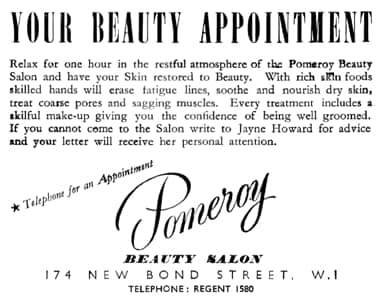
1946 Pomeroy Beauty Salon.

1947 Pomeroy with the ‘Dove in Flight’ logo.
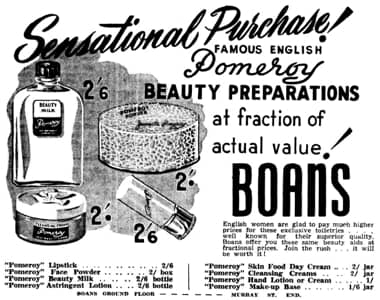
1947 Pomeroy products (Australia).

1947 Pomeroy Beauty Preparations.
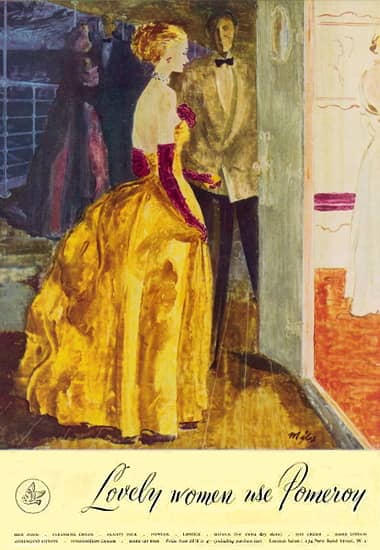
1948 Pomeroy.
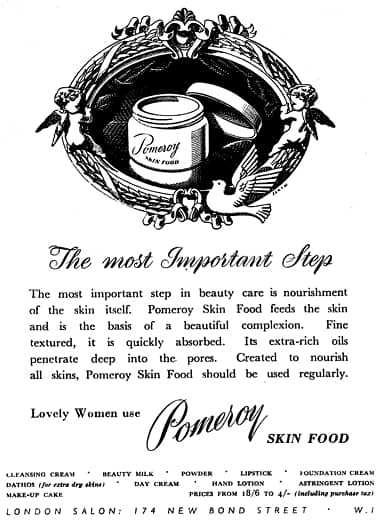
1949 Pomeroy Skin Food.
